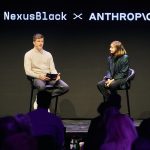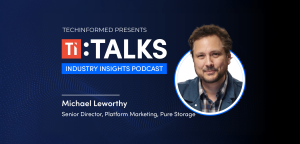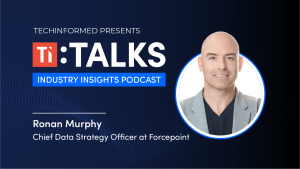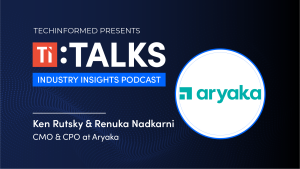
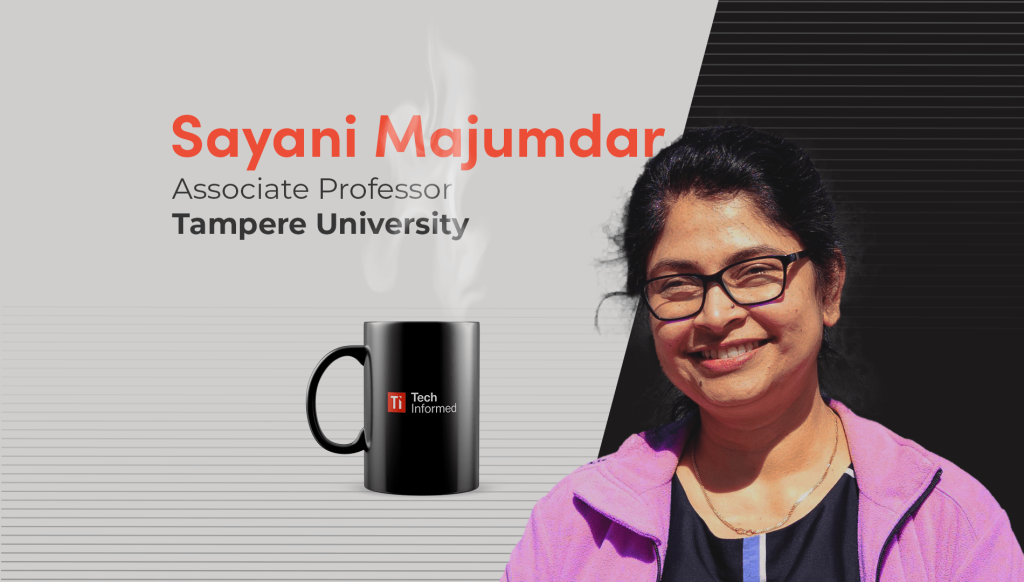
Sayani Majumdar, Associate Professor, Tampere University
Originally from Calcutta, India, associate professor Sayani Majumdar is a long-time resident of Finland and is currently researching and teaching at Tampere University in the southwest of the country. Her core research interest is the…
Originally from Calcutta, India, associate professor Sayani Majumdar is a long-time resident of Finland and is currently researching and teaching at Tampere University in the southwest of the country.
Her core research interest is the development of Neuromorphic Computing – a nascent technology inspired by the efficiency of the human brain, with potential applications in AI, autonomous vehicles, healthcare, and space exploration.
Over the course of our chat Majumdar claimed that this next generation of intelligent and adaptive computing and sensing also offers significant energy savings and more effective real-time decision-making, and that the smartest, most efficient LLMs are to be found in nature rather than code.
Majumdar also talks about the joys of being an international scientist and the benefits of the Finnish system, which has enabled her to conduct academic research while raising a young family.
When did you land in Finland?
My husband got a post-doctoral position in Turku when my eldest son was a few months old. We lived there for about nine years, so it will always hold a special place in my heart.
In the beginning I thought ‘let’s take some time off’ but it was quite isolating being on my own all day, so I started looking at options and through the university there I managed to get a scholarship sponsored by a private foundation – which funded my first research project.
What do you like about researching and working in Finland?
The independence you are given worked well for me as a young mother. No one interferes in anything, it’s a very trust-based system. You know your responsibilities and you know what needs to be done. When my son was sick, I was not in the lab, but when he was fine, I worked during my weekend. That kind of flexibility was helpful, and the supervisors were also supportive.
Another thing is that the childcare support is incredibly good. When I dropped my son off at daycare, I didn’t even worry about what he was doing. That’s something I think in those initial years, helped a lot.
What is neuromorphic computing?
It is about making computing more human-centric and studying also how the human brain processes data.
The human brain works completely differently to a computer’s and this requires a complete paradigm shift. The way current computers run means that the AI algorithms are very power hungry. And that’s because these computers were not designed for this kind of task. AI depends on a huge amount of data – billions of data sets – to make it understand what the correct answer or action is.
But humans, and even the smallest of insects, are good at certain things without any specific training. Take one small insect, the navigation path, or the collision avoidance path they have, it’s hard to replicate that in drones or in current machines.
It sounds like our brains are a lot more efficient that ChatGPT!
The human brain works in spikes whenever an event occurs, whereas computers transmit stuff all the time to the cloud which is a lot less efficient and more energy intensive.
So, a 24/7 surveillance camera. Or a health monitor. When there is nothing happening, a computer will continuously transmit data to cloud just not knowing what to look out for because there’s no ‘local intelligence.’
To imitate biological intelligence, the chips need to be more localised – you need to put them closer to the sensor so that it only communicates the relevant data to cloud, allowing it to work more efficiently.
With arrhythmia detection, for example, personalised trained chips can do 24×7 heartbeat monitoring of patients and can do anomaly detection at a much lower power and communication bandwidth cost than the current systems.
Besides healthcare and security surveillance, are there other applications?
Autonomous cars are another. Anywhere where you need chips to integrate and process data from multiple sensory sources simultaneously. Neuromorphic systems can adapt and “learn” from scenarios, improving their functionality over time.
For instance, if a car’s sensor when it is foggy or there is low visibility, the system can compensate by relying on data from other sensors, through associative learning, to make a safer judgement.
In space exploration, its use is also being actively being discussed. Space missions often have limited power sources, such as solar panels. Neuromorphic chips consume far less power than traditional processors, making them ideal for energy-constrained missions.
So, when Mars is at its farthest distance from Earth it takes more than 50 minutes to communicate in one direction so a simple instruction could take two hours. Chips that enable localised, event-based decision-making without the need for constant instructions from Earth, could be critical for autonomous operations in space.
You referred to a 2019 report that said training a single AI model takes up the same amount of carbon as five cars during their lifetime. What does this mean for the future of LLM development?
And that report was published in 2019 – the power demand from LLMs like GPT-4 are increasing exponentially.
The problem is that so far, we can actually keep up with these energy demands, but what will be challenging is when the hardware cannot keep up – in five-or ten-year’s time.
Moore’s Law – which states that the number of transistors on a chip doubles every two years while costs halve – is widely considered to be nearing its practical limits due to physical constraints in semiconductor fabrication. We simply cannot get these chips any smaller or squeeze more onto them.
The artificial intelligence we are seeing today is coming from the software side but if the hardware cannot give enough support to the software when AI workload magnifies enormously, then things will go very wrong.
How much energy would we save using neuromorphic computing?
Individual components wise: they can save a million-fold energy compared to current devices. But then we are still not able to switch fully to new technology. We are currently working towards a hybrid model.
You say there’s a need for innovation not only from device level but also in architecture for hardware support…
Algorithms need to understand the new devices because the ones we are using are based on old hardware. So, if the new algorithm can exploit the full potential of the new hardware, the system could become more efficient.
Are you investigating partnerships in this area?
Yes, in the US we have projects with the University of Massachusetts (UMAS) where they are doing pressure sensor-based computing. There are also other European projects. But hardware fabrication is expensive – you can spend billions on chip design and development – it’s very resource hungry.
Given how expensive it is, shouldn’t enterprises be more involved?
The big players are there- IBM, Intel, Samsung – they are running activities in this direction, but it is very good to have collaboration between industry and university together. It is not a mature technology yet, but it is coming….
What do you enjoy most about your job?
The best thing is nothing is repetitive, it’s something new all the time and it is always something challenging that you need to solve a problem. Also, getting to know so many very brilliant people and having the opportunity to work with the most brilliant minds. It is the human connection – you get to know so many people, their stories and how and why they chose this field. It is nice.
What do you do to relax, and switch off from work?
I enjoy listening to music. I used to be a singer a long time ago. My mother was a very good singer, and she trained me, mostly in songs from our Calcutta heritage. And when I am stressed or sad I find myself back in those words and connected to them. They are a vastly different collection of songs on many different topics, some of them are on nature, love, spirituality. They have the power to touch you.
How do you take your coffee (or tea)?
I am a very big tea fan. I come from the land of Darjeeling, and it is my favourite morning tea. Luckily in Europe now there are lots of sellers. I make it with loose leaves, the traditional way. No milk, no sugar.
Read more here: Will neuromorphic-controlled robots soon become a reality?
